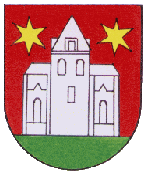
Tüller Family
Origins

The Tüller family originally comes from the village of Saanen, near the famous ski resort of Gstaad in the canton of Bern. It is a small family, with just 51entries in the Swiss telephone directory.
The name of an early emigrant branch of the family in the USA was anglicised as Diller. We have also found the spellings Tuller, Tueller, Thuler and Thueller.
Tüller crest

Louis married Fanny Elise Rochat in Bullet on 25 March 1893. She was born in Bullet on 13 November 1874, and was brought up by one of her two uncles after the early death of her parents. Her uncles were both fairly well-off, as one was a judge and the other a lawyer. When Fanny announced that she wanted to marry Louis Tüller, they were angry, and told her that if she married a "German" they would cut her off. Although Louis' family was originally from the canton of Bern, he was the fourth generation to be born in the canton of Vaud, he did not speak a word of German and had a strong local accent. However, Bern had dominated the canton of Vaud for many years, resulting in a strong inter-cantonal resentment. Fanny therefore married at the age of 18 against her guardian's wishes.
Barn on the Tüller farm, Val-de-Travers
Louis and Fanny had ten children, four of whom died in infancy. Fanny herself died in 1907 at the early age of 32 and her oldest daughter, Albertine Jeanne played a great part in bringing up her younger brothers and sisters. After overcoming his chagrin at Fanny's premature death, Louis-Auguste married Olga Lucie Patthey in 1918, but his children found relations with their young stepmother difficult and the family soon dispersed, either to marry or to work away from home.
Two of Louis and Fanny's sons moved to France: one lost touch completely with the family, having walked out in a rage, although we have now traced him to Troyes in 1929. The other, Gaston Albert Tüller, settled in Carcassonne and has descendants in several parts of the country. The remainder of the family remained in Switzerland, where most of them married and founded families. Albertine Jeanne Tüller married Gustave Henri Huguenin-Virchaux in 1920.
Our branch of the family is from Zweisimmen, a short distance from Saanen, and we have traced it back to Hans Tüller and his wife Margreth Bramhasen (or Hasen), who married on 1 February 1679. They had eight children in Zweisimmen, and after Magreth's death, Hans had three more children with his second wife, Barbara Schusi.
Hans and Margreth's oldest son, Jakob Tüller, married Barbara Martig, a young widow, in Zweisimmen on 8 June 1708. They had six children, including another Jakob, who married Elisabeth Steck on 12 February 1741 and migrated to the canton of Neuchâtel where he had a small farm near Boveresse.
Jakob and Elisabeth had eleven children, all born on the hills above Boveresse and baptised either there or in one of the other nearby villages. Their seventh child, Christian Ludwig (or Christ Louis) married Rose-Marie Rochat on 4 March 1781 in Romainmôtier, just over the border in the neighbouring canton of Vaud. Rose-Marie was born in Valeyres on 12 April 1761.
Christian and Rose-Marie had six children, one of whom died in infancy. Their second child, Jaques Frédéric Tüller, was born in Buttes on 27 June 1788, and married Esabeau Mélanie Prisi in St-Sulpice on 1 July 1826. She was born in Travers on 6 July 1796, although her ancestors were also from the canton of Bern.
Jaques and Esabeau had just one son: Louis Frédéric Tüller (known as Frédéric), who was born in St-Sulpice on 3 May 1831. He was a farmer, with a farm called La Bolène at Les Rochats, near Bullet in the canton of Vaud and a stable on the Creux-du-Van where his animals spent the summer months. He married Louise Thévenaz (born in Bullet on 8 July 1832) on 20 May 1854.

Le Creux-du-Van
Frédéric and Louise had four sons, the youngest of whom, Louis Auguste Tüller, was born on 4 August 1866. Louis lost an eye as a child when he stumbled while sharpening a stick with his penknife. He was a joiner/cabinetmaker/carpenter, who acquired expertise in his trade by going on what was called the "petit Tour de France" and working for various French master craftsmen. He belonged to an order called the Compagnons, and could not marry until he had finished his long period of training.
The Compagnons were a trade guild, dating from the 15th century which had a strong revival at the beginning of the 19th century. Members were admitted after a period of probation during an initiation ceremony which borrowed from the Catholic Church and was similar to that of the freemasons, who subsequently used much of the Compagnons' terminology. During his "Tour de France", the Compagnon received brotherly aid in each town he visited: food, lodging and work. The Compagnons undertook never to work for less than a certain salary; they organised strikes and placed vetoes on offending employers or towns. However, rivality between different groups of Compagnons prevented them from playing a greater role in defending employees' rights. In time, the birth of heavy industry and the trades union movement led to their demise.